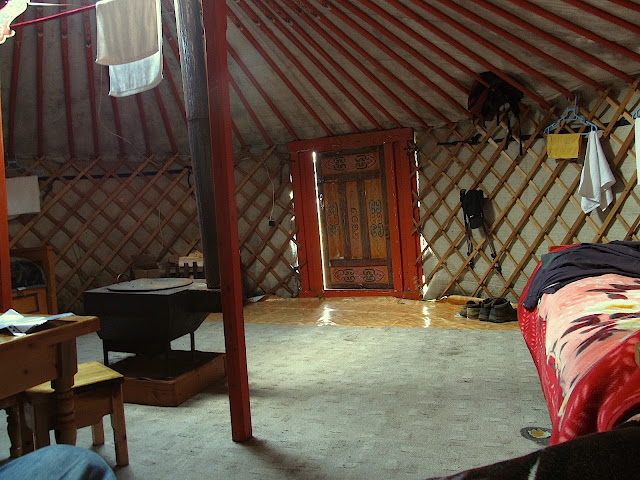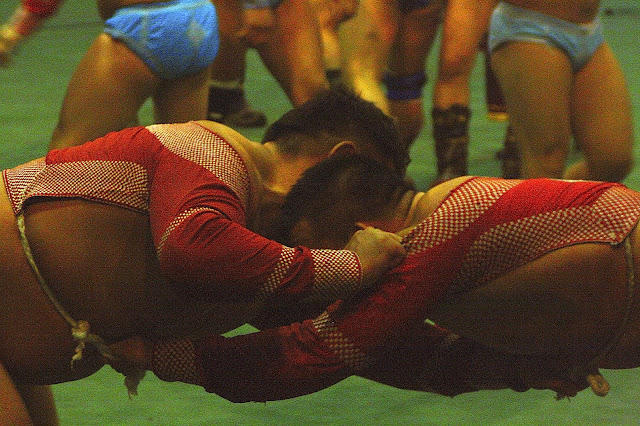On August 2 we left Ulaanbaatar by air for a 90-minute flight to the Murun Airport in Northern Mongolia. Most of us on the flight were headed to Lake Khovsgol for the Sunrise to Sunset Marathon and Ultra-Marathon. We and all of our gear were picked up at the airport by camp staff for transportation by van to the Toilogt Ger Camp located approximately 100 kilometres from Murun.
Toilogt Ger Camp is located on the western shore of Lake Khovsgol 17 kilometres from the southern tip of the lake. On arrival we were assigned to our gers or teepees (yes, there are teepees in Mongolia). The 2 wooden ger-shaped buildings in the photo are the restaurant and the performance venue where local folk music artists perform for guests.
Assembled for a first briefing on marathon details this constitutes about half the number of participants.
This glimpse of Lake Khovsgol only hints at its proportions. In surface area this is the second-largest lake in Mongolia but it is by far the deepest at up to 262 metres deep and it is the world's 14th-largest source of fresh water.
This hazy view of the mountains behind this shallow arm of the lake gives some sense of the altitude. Toilogt Camp sits at 1600 metres. The highest altitude on the marathon route was 2300 metres.
There were many lakeshore walks, each with its particular view.
Toilogt Camp owns this boat and conducts excursions around and across the lake. Many come to this area to fish and one of the people on our flight from UB had come for a week of fly fishing. Mongolian fishing permits for foreigners are strictly for catch and release only.
A view from inside our ger which we shared with another couple who are colleagues from Judith's school. We had good weather during our week in Khovsgol with only a little rain. The early mornings are chilly though so a fire helps to start the day.
A few guests at the camp had come for an 11-day horse-trekking expedition. Preparation and packing was critical as they were heading into deep wilderness far from amenities of any kind. The camp employs experienced Mongolian horsemen to act as guides and to oversee all preparation and packing for the trips.
There is a significant amount of gear and supplies needed and its a study in precision to watch the horsemen organize and pack everything while evenly distributing the weight.
Yes, those are wooden saddles.
One pack horse ready, with a few more to load.
Canoes and kayaks were available for guests to use. The canoes were in better shape than the kayaks so we opted for a canoe to paddle along the lake shore.
Sunrise to Sunset is a bit of a misnomer as our day began significantly before sunrise. Our wake-up call was at 2 a.m. on August 7, breakfast was at 3 followed by backpack checks before our start time at 4 a.m. The first 2.5 km was through the forest leading north from the camp and this section was completed with flashlights or headlamps. Several kilometres down the road we were lucky to catch this view of the sunrise as it made its appearance through the clouds.
Does fireweed grow everywhere? It, and many other wildflowers were in bloom. The green splash of paint on the tree is a route marker, not needed so much on this section but critical once we were well into the wilderness. We never had the intention to run any of the 42 km route but we made good time on the flat sections, knowing the ups and downs would be much slower. Our goal was to complete the route - and not be injured in the process!
Our first test came about 12 km from camp as we began our ascent to Chichee Pass in a vertical rise of 650m over 5 km. Amazing views in every direction were our reward. And yes, we were above the clouds.
The second vertical rise came at the 25 km point. It was harder, being on much more uneven ground and more steep. As we arrived at Khirvesteg Pass, however, we had this view. Just beyond the ridge of the mountains in the background is Russia.
While the uphill climbs were challenging the downhill portions were brutal. This may look like a lovely grassy meadow but underfoot it was rocky and unstable. These sections made us glad we had opted to take a walking pole with us. The dark figure ahead of Judith is a Mongolian horseman whose job that day was to ensure all the race participants were accounted for as they passed the 28 km point. Having chosen to walk the course we were the last so the horseman was our companion for the final sections of the race.
Just under 13 hours after our start we walked across the finish line. We were tired and we had sore muscles but we still upright and smiling. And it was well before sunset!
The day following the race was one of rest and relaxation but there was a celebratory dinner held in honour of all race participants and to acknowledge the 15th anniversary of the Mongolia Sunrise to Sunset Marathon and Ultra-Marathon.

















































